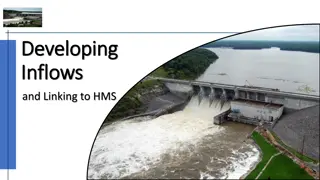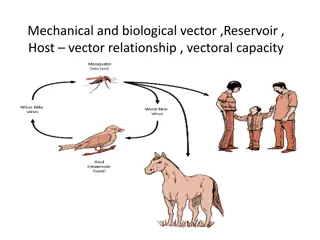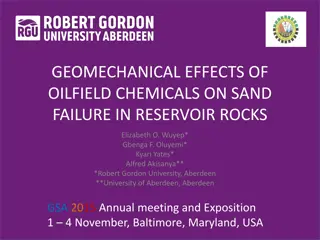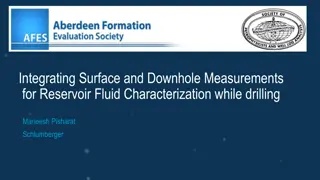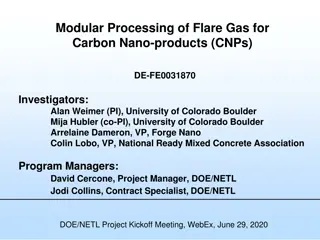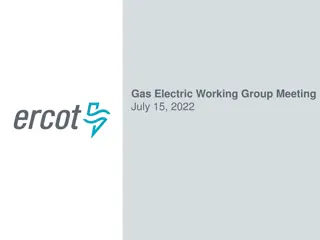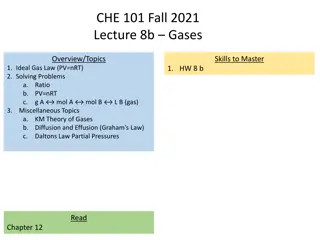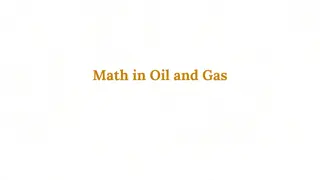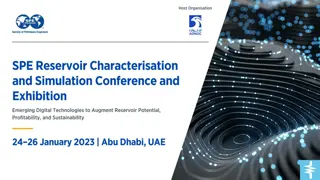Estimating Original Gas In Place for Reservoir Management
This study focuses on utilizing GIS technology to estimate Original Gas In Place (OGIP) for reservoir management, with the aim of enhancing oil and gas production, reducing risks, and optimizing recovery. The project outlines the background of reservoir management, introduces the process of volumetric estimation, and highlights the historical methods used for calculating gas in place. Current workflows involving ArcMap, Petra, and Excel are discussed, along with the objective of creating a streamlined workflow using ArcToolbox tools. The research aims to leverage geospatial analysis to improve decision-making in the oil and gas industry.
Download Presentation

Please find below an Image/Link to download the presentation.
The content on the website is provided AS IS for your information and personal use only. It may not be sold, licensed, or shared on other websites without obtaining consent from the author.If you encounter any issues during the download, it is possible that the publisher has removed the file from their server.
You are allowed to download the files provided on this website for personal or commercial use, subject to the condition that they are used lawfully. All files are the property of their respective owners.
The content on the website is provided AS IS for your information and personal use only. It may not be sold, licensed, or shared on other websites without obtaining consent from the author.
E N D
Presentation Transcript
GIS for Reservoir Management: Estimating Original Gas In Place Jeffrey Vu, M.GIS Candidate Dr. Patrick Kennelly, Advisor GEOG 596A Winter 2013 1 of 24
Outline Background Introduction Objectives Data Methods Anticipated Results Timeline Future Development References Acknowledgements 2 of 24
Background What is reservoir management? Use of earth sciences and petroleum engineering to forecast and manage the recovery of oil and natural gas (hydrocarbons) in place from a field or a prospect Reservoir management plays an important role in the oil and gas industry by evaluating the greatest economic recovery from a reservoir. - Increase oil and gas production - Decrease risk - Maximize recovery and minimize costs Reservoir Engineers typically don t use GIS. They normally use Microsoft Excel for all sorts of modeling, including analysis. 3 of 24
Introduction Volumetric estimation is the common technique of the geologists to calculate hydrocarbons in place based on geologic mapping and reservoir engineering data. OGIP: Original Gas In Place MMCF: Million Cubic Feet http://discoverygeo2com/Papers/Reservoir%20Eng%20for%20Geos%2032pdf 4 of 24
History and current process Determine reservoir gas in place using BASIC programming language BASIC (standing for Beginner's All Purpose Symbolic Instruction Code) 5 of 24 Cranmer, John L.: BASIC Reservoir Engineering Manual , PennWell (1982) 24-25.
History and current process (cont.) Calculate original gas in place using Excel Calculate gas in place using Petra 6 of 24 http://petroleumsupport.com/volume-reservoir-and-gas-reserve-calculator-spreadsheet/
Current workflow ArcMap Geologists generate net pay, porosity, water saturation grids Input Data Calculate OGIP using formulas PLSS sections Generate centroids Extract Values to Points Petra Excel 1320 sq.ft. x 1320 sq.ft. = 40 acres PLSS section (640 acres) 7 of 24
Objectives Create a workflow using out-of-the-box tools in ArcToolbox as a screening workflow to estimate the Original Gas In Place (OGIP) for the Reservoir Engineers Streamline the workflow to avoid human error in importing and exporting data Allow user-drawn polygon as input to increase flexible analysis of fields or prospects Use folder structure to manage data inputs and results Run different scenarios Estimate the OGIP under different uncertainties and assumptions 8 of 24
Proposed workflow (using ArcGIS) Grids exported from Petra Net pay . . . . . . . . . . . . . . . . . . . . . . . . . . . . . . . . . . . . . . . . Porosity . . . . . . . . . . . . . . . . . . . . . . . . . . . . . . . . . . . . . . . . . . . . . . . . . . . . . . . . . . . . . . . . . . . . . . . . . . . . . . . . Calculate OGIP . . . . . . . . . . . . . . . . . . . . . . . . . . . . . . . . . . . . . . . . . . . . . . . . . . . . . . . . . . . . . . . . . . . . Average values 40-ac fishnet Intersected . . . . . . . . . . . . . . . . . . . . . . . . . . . . . . . . . . . . . . . . . . . . . . . . . . . . . . . . . . . . . . . . . . . . . . . . . . . . . . . . . . . . . . . . . . . . . . . . . . . . . . . . . . . . . . . . . . . . . . . . . . . . . . . . . . . . . . . . . . . . . . . . . . . . . . . . . . . . . . . . . . . . . . . . . . . . . . . . . . . . . . . . . . . . . . . . . . . . . . . . . . . . 1320 sq.ft. x 1320 sq.ft. = 40 acres . . . . . . . . . . . . . . . . . . . . . . . . . . . . . . . . . . . . . . . . OGIP map Water saturation 9 of 24
Data Exported grids from Petra Net pay grid is required All input grids must have the same coordinate systems and cell sizes User s parameters 10 of 24
Methods Data management: User-defined folder structure User-drawn polygon to increase flexibility in selecting areas of interest Reusable workflow to run different scenarios Python codes to check inputs (grid or constant value) User-drawn polygon Copy to project s folder YES Is a grid? NO 2 2 2 2 2 2 Create a grid based on user- drawn polygon 2 2 2 2 2 2 User s input = 2 2 2 2 2 2 2 2 2 2 2 2 2 2 2 2 2 2 2 11 of 24
Con (Spatial Analyst) Performs a conditional if/else evaluation on each of the input cells of an input raster 0 12 26 50 -5 12 26 50 34 19 44 0 34 19 44 -10 48 42 64 12 48 42 64 12 2 0 24 0 2 -15 24 -47 Set raster cell to 0 when VALUE < 0 12 of 24
Reclassify Reclassifies or changes the values in a raster 1 1 1 1 11 12 26 50 1 1 1 34 19 44 1 1 1 1 48 42 64 22 1 1 1 1 2 -15 24 0 NoData Set raster cells to NoData or 1 13 of 24
Intersect & Fishnet Polygons Convert all raster datasets to polygon features and intersect with each other Create 40 acre fishnet polygons in Python Intersected fishnet polygons Net pay Porosity Water saturation 1320 sq.ft. x 1320 sq.ft. = 40 acres 14 of 24
Zonal Statistics as Table Create additional fields in the fishnet polygons feature class Run Zonal Statistics as Table tool for all input grids . . . . . . . . . . . . . . . . 15 of 24
Join Tables Join Zonal Statistic tables to fishnet polygons table Remove join before joining another table 16 of 24
Calculate Fields Calculate fields, including OGIP OGIP Polygons 17 of 24
OGIP Raster Create OGIP centroids Generate OGIP raster grid Create OGIP contours 18 of 24
Anticipated Results Table with calculated of OGIP OGIP grid OGIP contour map bcf (billion cubic feet) 19 of 24
Timeline April 2014 Collect Data OGIP Formula Python Scripts Model Builder Test CalGIS March 2014 February 2014 January 2014 20 of 24
Future Development Calculate remaining gas in place Calculate net revenue interest by leases automatically 21 of 24
References Reservoir Engineering for Geologists http://discoverygeo.com/Papers/Reservoir%20Eng%20for%20Geos%20 3.pdf Cranmer, John L.: BASIC Reservoir Engineering Manual , PennWell (1982) 24-25. Volume Reservoir and Gas Reserve Calculator Spreadsheet http://petroleumsupport.com/volume-reservoir-and-gas-reserve- calculator-spreadsheet Basic Geology and Volumetric Analyses http://www.petrocenter.com/reservoir/re01.htm ArcGIS 10.1 Help http://resources.arcgis.com/en/help/main/10.1/ 22 of 24
Acknowledgements Dr. Patrick Kennelly - Professor of Geography, Penn State University Penn State Online Geospatial Program Instructors David Bumbaugh Reservoir Engineer, BP Jacob Maggard Geospatial Capabilities Team Lead, BP 23 of 24
Questions? Comments? 24 of 24




